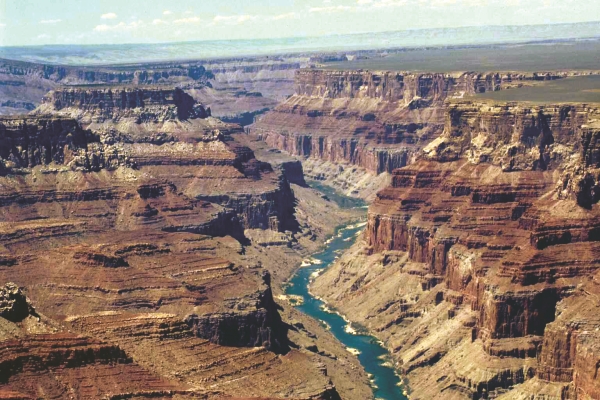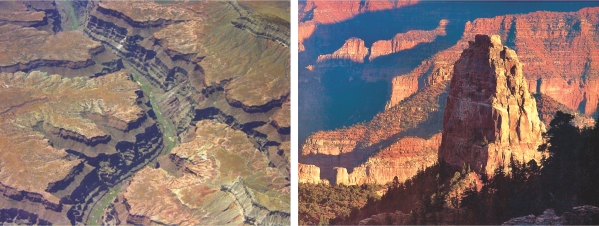| Home - Back Issues - The Team - Contact Us |
 |
| Volume 10 |Issue 34 | September 09, 2011 | |
|
|
Travel Nature's Amazing Architecture The Grand Canyon
Azizul Jalil Standing at the fenced rim of the empty, lake-like depression created by the forceful Colorado River over millennia, we viewed with utter amazement an extraordinary natural creation called the Grand Canyon. Not surprisingly, we have been hearing from our childhood that it is one of the seven 'Wonders of the World.' Truly, it deserved to be designated as such. Five million people come to see it every year. Living for many years near the eastern part of the country was no excuse for not visiting this world- famous sight near its western part. We redressed the deficiency this year by taking a daylong, 250 miles bus trip by travelling from Las Vegas in the State of Nevada to the Grand Canyon in Arizona. Near the border of the two states, we had the opportunity to see the Hoover Dam, a large hydro-electric project on the Colorado River supplying most of the electricity needs of Nevada and Arizona. The US Government built it in 1931-36 and Boulder City, a new township, was established nearby, to house about five thousand construction workers with all civic facilities. The 726 feet high concrete dam and the bridge built over a huge arch in recent years for the bypass road were attractive. Originally called the Boulder Dam, it was later named after president Hoover in 1947. Annually, one million people come to see this man-made marvel and high engineering feat. We were concerned about the strains of a long journey and boredom of the barren land and grey mountain scenery on route to the Grand Canyon. That apprehension was unfounded. To our surprise, there was quite a bit of greenery and small plants on the way side and even the low stony mountains parallel to the highway had some mossy green covering them. It was a pleasant drive as we feasted our eyes on the surroundings. When we entered the vast Grand Canyon National Park covering 270 miles of the Colorado River, large spruce and other trees appeared and the entire area became green and enjoyable. Since we left our hotel at seven in the morning, the tour company provided us with boxed breakfast, lunch and water bottles. It was all healthy food and fruits. A coffee and refuelling break at a truck-stop for thirty minutes during both sides of the journey was most welcome.
During their visits, some of our friends had stayed at the Grand Canyon Park for a few days, seeing it from numerous viewing areas covering many different parts of this gigantic and marvellous work of nature. In our case, a few hours would have been sufficient but a sudden thunderstorm immobilised us for half an hour at the Bright Angel Lodge at the South Rim, where our big bus had terminated its journey. The storm took away precious time from the three hours of viewing we were allowed by the tour company. We used the rainy period for finishing our lunch. There was further time loss due to delayed bus service to the viewing points. The Park Service provides free shuttle buses between various points and the frequency of this service is every 15 minutes and the journey usually takes, with a few stops, about 20 minutes. Eventually we got into one of the buses, but soon realised that we had to walk about ten minutes up an incline to the look outs at Mater Point, the last of such in that part of the Canyon. Once you get near the chain fence at the rim of the deep Canyon, you realize the vastness and beauty of successive layers of stone, which have been hewn by the mighty river waters through many thousands of years. The silent majesty of the enormous, curved mountain range completely devoid of living creatures was awesome. The unevenly broken, shell-like mountain tops and sides appeared to be the work of an eccentric and unconventional architect who got a large mountain and giant bulldozers and stone-cutters to play with for many years. Evidently, the river's course was meandering as it twisted and detoured at places where it found obstruction, which it could not force through by gradual erosion. The unusual shape of the canyon is also formed by volcanic activity, which deposited lava over the area a long time ago. The Canyon was one mile deep here and one could get a view of 18 miles across to the North Rim. The stones were greyish and silvery at places but were reddish in others. In fact, the red stones looked like the brick walls of Delhi's Red Fort. The brick shape is formed by erosion and the redness is caused by iron oxides leaching out of the layers of Red limestone above it, staining its outward face. Many caves and arches can also be seen on the Canyon walls. To us, it seemed to be a three-dimensional impressionistic painting in soft pastel colours on a huge canvas, before which you feel utterly insignificant. Our emotions and experiences were simply indescribable. Commercial helicopters fly over the Canyon and such daring, often dangerous rides are available for a high price. During their visits in previous years, some of our friends had a good and we suppose-a nervous look at the entire gorge, flying between its two sides. However, our ten-year old grandson, after reading on the Internet, had warned us against taking such risks. We were more than compensated when our return flight from Las Vegas took us over a large part of the Grand Canyon. It was a sunny and clear late morning and the panoramic view of the Canyon from about fifteen thousand feet of our Boeing aircraft was magnificent. Perhaps by design, the pilot chose a leisurely and winding route to give him and the passengers a good look at nature's wonder below. It was a generous bonus we thankfully accepted.
Copyright
(R) thedailystar.net 2011 |

